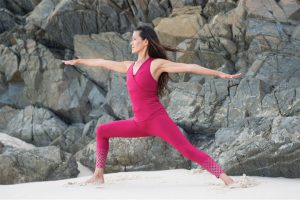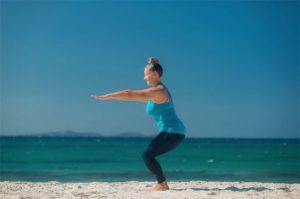 In her book, Yoga for Diabetes: How to Manage Your Health with Yoga and Ayurveda, Yoga teacher Rachel Zinman presents a highly motivational and personalized guide that will enable readers to incorporate Yoga into their daily diabetes management plan. Rachel was diagnosed with diabetes in 2008. In this article, she shares her journey and what she’s learned about living and thriving with diabetes. She also includes an overview of asanas that are especially useful in managing diabetes.
In her book, Yoga for Diabetes: How to Manage Your Health with Yoga and Ayurveda, Yoga teacher Rachel Zinman presents a highly motivational and personalized guide that will enable readers to incorporate Yoga into their daily diabetes management plan. Rachel was diagnosed with diabetes in 2008. In this article, she shares her journey and what she’s learned about living and thriving with diabetes. She also includes an overview of asanas that are especially useful in managing diabetes.
The first time I tried Yoga, I was 17. I didn’t know anything about Yoga but I liked the way it made my body feel, light and free. Yoga also pushed my body to its limits, I loved the challenge but at the same time there were some red flags. My persistent practice led to a radical detoxification. It felt like everything I had poured into my young body both physically and emotionally was being scrubbed clean. Every time I mastered a pose I’d have some sort of reaction.
I didn’t know it at the time but that was the start of my journey with diabetes. I wasn’t symptomatic, I didn’t have unusual blood sugar readings but I knew something wasn’t right. Through my 20’s and 30’s I practiced daily and eventually began to teach.
When I was first diagnosed with LADA (Latent Autoimmune Diabetes in Adults) at the age of 42, I was floored. By then, I’d been teaching Yoga and training teachers for over 25 years and was supposed to be an example of someone who “lives” Yoga. But there I was, so sick I couldn’t get out of bed.
Type 1 diabetes is usually thought of as a disease that strikes in childhood, but of the 400 million people worldwide suffering with diabetes about 10 percent are diagnosed with LADA.
When I educated myself more about my condition, and that a LADA diagnosis describes the slow destruction of insulin-producing beta cells… I knew that Yoga had played a pivotal role in helping me to preserve my insulin production and stay sensitive to the insulin I was still producing. More importantly it helped me stay positive.
No matter what type of diabetes one has, it’s stressful.
In my own experience of living with diabetes, Yoga encourages me to breathe and connect with myself. When my mind is focused on a posture there’s just no room for stressful thoughts
But there are also many other benefits: Weight loss, better sleep, increased insulin sensitivity, balanced emotions, flexibility, strength, increased breathing capacity, better concentration, and a sense of joy and wonderment in spite of adversity.
Initially, being a Yoga teacher trainer, I wanted to create a specific training for Yoga teachers on how to meet the needs of someone living with diabetes in their Yoga class. When I shared my idea with a close friend she suggested I think bigger.
Why not write a book specifically for people living with diabetes and their caregivers and share all the tips and tricks I’d used to thrive in spite of my diagnosis? It could also be a user manual for Yoga teachers.
Diabetes has reached epidemic proportions. It’s estimated that one in three Americans will soon have diabetes. That’s a lot of people who could benefit from Yoga!
Once I had the idea, I knew what I wanted. A book that was beautiful and encouraging, the sort of book you keep picking up not only because of the content but because the photographs are so engaging.
One of the big challenges when living with diabetes is to stay motivated. When we’re not constantly checking our blood sugar levels or counting carbs, we’re dealing with higher levels than we’d like (called Hyper Glycaemia) or dangerous lows (called Hypo Glycaemia). Living with diabetes is a rollercoaster and we can and do suffer from burnout.
That’s why the book is more than just Yoga postures, breathing practices, and meditations that are specific to diabetes. It’s about Ayurveda and how Ayurveda has been treating diabetes for thousands of years. Helping the person to determine their unique constitution, the book assists them in finding the right practices for them and their type of diabetes.
When I first started experiencing symptoms I was encouraged by my Yoga teacher to use Ayurveda, to help manage my condition. It was a revelation to discover that Ayurveda, the sister science to Yoga has been treating diabetes for over 4,000 years. In Ayurveda diabetes is called Prameha, which means major disease, because it affects every organ and every cell in the body.
Besides writing a book full of practical techniques and benefits it’s my personal journey of how Yoga has supported me to live with this condition for the last nine years.
Here’s what I’ve learned so far:
o I am stronger than I think. When I feel depleted a posture like handstand encourages me to go the distance.
o Yoga inspires bravery! When I feel insecure, I throw myself into a difficult pose and will myself to rise to the challenge.
o Yoga opens me in the toughest moments, giving me the go-ahead to let the tears fall.
o And Yoga enables me to accept that life is a constant balancing act. No matter how much I want to be in control there are going to be highs and lows. The practice can feel ordinary or super real. Really it makes no difference. Ultimately, It’s the one doing the practice that matters.
Embracing this, knowing this, has made all the difference.
As a long time Yoga teacher and practitioner who was diagnosed with diabetes in adulthood I feel absolutely grateful that I was introduced to Yoga long before my diagnosis. Without Yoga I don’t think I would have adjusted as well as I have to managing my condition.
Ayurveda categorizes diabetes into two types (curable and incurable) It also goes one step further in seeing the disease as manifesting in the three doshas, Vata (air and space), Pitta (fire and a small amount of water), and Kapha (water and earth). Vata diabetes is divided into 4 types, Pitta diabetes into 6 types, and Kapha diabetes into 10.
With such a complex and detailed for treating diabetes, the physical practice of Yoga can be of immense benefit, especially if the person knows their Ayurvedic constitution. Knowing the right practice for your constitution and the type of diabetes you have means you can work with more awareness to manage your health.
However, as a beginner or someone wanting to bring Yoga into your daily life with diabetes there are certain postures that benefit all types of diabetes and address specific symptoms common to the disease.*
Below are my top 6 picks for an all round practice for any type of diabetes. These poses:
- Increase circulation
- Reduce stress
- Increase insulin sensitivity
- Promote weight loss
- Support the digestion
- Improve mood
DISCLAIMER: Integral Yoga Magazine offers information only, no medical advice. You should consult a health care provider before starting any new exercise regime. This is particularly important if you are overweight, pregnant, nursing, regularly taking medications, or have any existing medical conditions. This website may not be tailored to your current physical and mental health. We accept no liability whatsoever for any damages arising from the use of recommendations in this article or on this website.
Down dog (Adho Mukha Savasana): This pose is an inversion, lowers blood pressure and reduces stress, while nourishing the spine. It’s also great for weight loss, circulation and improving mood.

Start on your hands and knees
Lift your sitting bones high to the ceiling
Your sitting bones are the apex of the pose
Spread your fingers wide as you place pressure into your thumb and forefinger
Feel the inner upper arms working towards each other
You can have the legs straight or slightly bent if you feel that there is too much weight in your arms and upper body
Breathe deeply here.
Warrior 2 pose (Virabhadrasana 2): This pose strengthens the thigh and the muscles around the knee. It helps to increase insulin sensitivity due to the strong muscular action of the front thigh.

Stand with the legs one legs length distance apart
Turn your front foot out and bend the front knee, stacking the knee over the ankle
Turn the back hip and back foot in slightly so there is no tension in the lower back
Raise the arms to shoulder height and gaze over the front hand
Try and hold this pose for at least 15 breaths
Chair pose (Utkatasana): This pose also builds core strength to support the lower back.

Stand with the feet inner hip width apart
Sit down like you are about to sit in the chair
Your knees should stay parallel to each other
Make sure your chest stays open and you feel the abdomen engage
Raise the arms to shoulder height
This is another great pose to strengthen the legs and increase your insulin sensitivity
You can move in and out of this pose to pump the thighs and help your thigh muscles work even harder
Revolved right angle pose (Parivrtta parsvakonasana):

Come onto your hands and knees.
Step your left foot in between your hands and bring your torso upright so you are in the Low Lunge position
Check to make sure your front knee is stacked over your ankle and that your back hip and back knee are in line
As you move into the pose, your hip will come slightly forward out of alignment
Place your hands in prayer position at your heart
Inhale and turn your torso to the left
Exhale and place your upper right arm against your outer left thigh
The more you lever your upper arm against your outer thigh, the more deeply you can twist
The deep twist massages the internal organs and improves digestion
It brings nourishment into the discs between the vertebrae of your spine increasing circulation
Take 5 deep breaths here twisting deeper on the inhalation and resting in place on the exhalation
Turn back to center on your final exhalation. Return to your hands and knees and repeat on the other side
Forward facing hero pose (Adho mukha virasana): This pose stretches the spine and supports the nervous system and it lowers blood pressure and reduces stress.

Sit upright and take your big toes together and your knees mat width apart
Slowly walk your hands forward until your spine extends
Keep your arms shoulder width apart
You can rest your forehead on the floor or turn your cheek to one side
Reclining buddha pose (Supta baddha konasana): This posture increases circulation to your pelvis, supports your reproductive and hormonal system, and is a calming and grounding posture.

Lie on your back, bending the knees and bringing the soles of the feet together
The feet can be close to the groin or further away depending on what’s comfortable
Close your eyes and place your hands on your belly
Breathe deeply and relax for 20 breaths
About the Author:
 Rachel Zinman was diagnosed with diabetes in 2008. It took six years for her to accept her diagnosis of type 1 LADA diabetes. She started Yoga in high school when she was 17 and by the age of 19 she was hooked. Rachel is passionate about the deeper aspects of Yoga and its ability to heal and inspire. She has spent the last 30 years practicing enthusiastically as well as teaching nationally (in Australia) and internationally since 1992. Rachel was a professional dancer from a young age and trained as a Waldorf educator teaching in both Australia and New York City.
Rachel Zinman was diagnosed with diabetes in 2008. It took six years for her to accept her diagnosis of type 1 LADA diabetes. She started Yoga in high school when she was 17 and by the age of 19 she was hooked. Rachel is passionate about the deeper aspects of Yoga and its ability to heal and inspire. She has spent the last 30 years practicing enthusiastically as well as teaching nationally (in Australia) and internationally since 1992. Rachel was a professional dancer from a young age and trained as a Waldorf educator teaching in both Australia and New York City.
She is also a published poet and author, award-winning musician, mother, partner and amateur filmmaker. Interested in all aspects of health and wellbeing, she started her blog, Yoga for Diabetes, to share with the online diabetes community how Yoga has helped her to manage her diabetes.
Rachel’s articles on Yoga and diabetes have been featured in Diabetes Daily, A Sweet Life, Insulin Nation, Beyond Type 1, LyfeBulb, Diabetes Counselling Online, Diabetes Alive, Veranda Magazine, Yoga Trail, Yoga4tv, Cleans for a Cure, Mind Body Green and DoYouYoga and most recently in the #1 bestseller, Unleash Your Inner Diabetes Dominator.
Yoga for Diabetes was listed as one of the best blogs for January 2016 by Diabetesmine, and was named best blog in the April 2017 issue of Low Carb Magazine. Rachel is a featured expert for several online resources for Yoga and diabetes. Rachel Zinman’s book, Yoga for Diabetes: How to Manage Your Health with Yoga and Ayurveda is available here.
*Important Note: Integral Yoga Magazine offers only information and no medical advice. You should consult a medical practitioner before starting this or any new exercise regime. This is particularly important if you are overweight, pregnant, nursing, regularly taking medications, or have any existing medical conditions. This website may not be tailored to your current physical and mental health. We accept no liability whatsoever for any damages arising from the use of this website.

